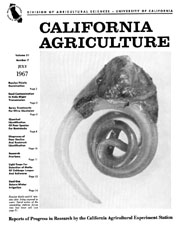


University of California
California Agriculture
|
|||
|
|||

Russian thistle seed 61 minutes after being exposed to water. Spiral action of the unwinding embryo forces root into loose soil.
July 1967
Volume 21, Number 7 General Information |
|||
|
University of California, 1301 S. 46th St., Bldg. 478 Richmond, CA
|